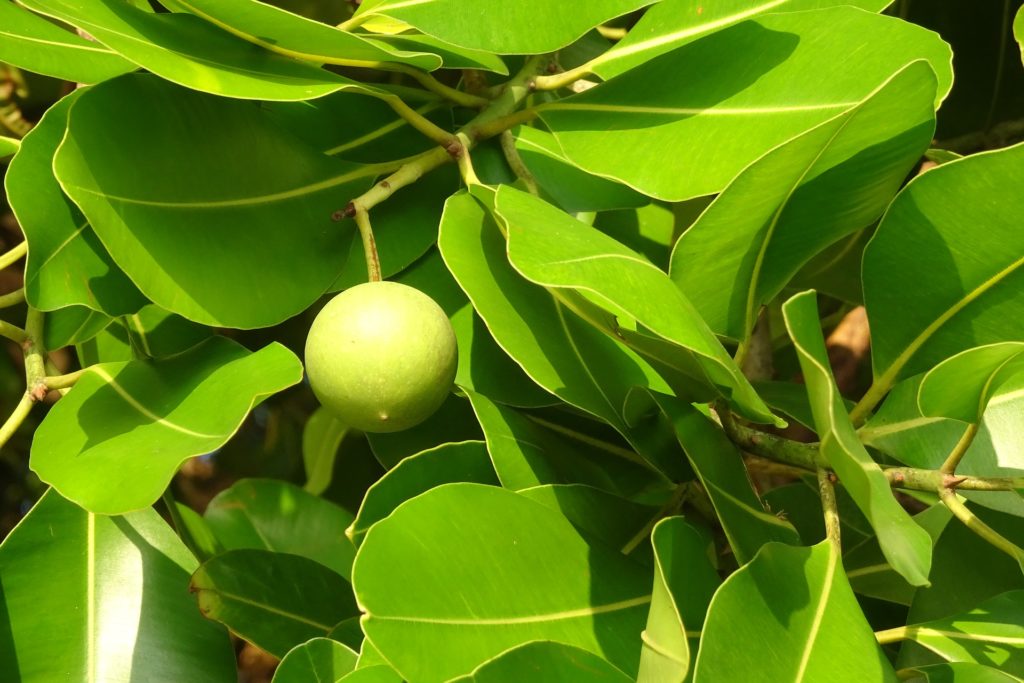When we hear there’s an organic oil that can be used for skin concerns such as anti-aging, acne, stretch marks, scars, razor burn, bug bites, and can be used for softer, smoother hair, we’re interested. But we are also skeptical. What does the research say? Anecdotal evidence supports beautiful hair and skin on those who use Tamanu Oil. Many people swear by Tamanu Oil for clearing up acne or fading an old scar. But does science back the Tamanu Oil folklore? What is Tamanu Oil? And how do you use it? We did Tamanu Oil Research.
ABOUT TAMANU OIL
The locals call it “Green Gold”. Pacific island folk medicine uses Tamanu Oil for a host of natural remedies. In Southern India, Tamanu Oil is used for many skin ailments. In Taiwan, it is used for hair. Tamanu Oil has gained attention because of its’ rare beauty benefits. The oil comes from a nut of the Tamanu Tree. The Tamanu Tree is commonly found in Polynesia. Within the region, Tamanu Oil is prized for hair, skin and a host of medical uses. Ample anecdotal evidence exists for these uses. Countless people swear by Tamanu Oil. But there have been limited research studies on Tamanu Oil efficacy. Studies to date show a promising organic oil with many versatile uses.
What do we know about Tamanu Oil?
While used for years in Polynesian regions, Tamanu Oil is only a recent discovery to many of us.
Tamanu oil is a topical healing agent that is:
- antineuralgic
- anti-inflammatory
- antimicrobial
- antibiotic
- anti-oxidant
TAMANU OIL RESEARCH STUDIES
Tamanu Oil has been long associated with many health and beauty benefits. Research studies are still developing for the documentation of several promising medical uses. There is even research into Tamanu Oil’s potential benefit for cancer and HIV.(1)
But other Tamanu Oil uses are already well documented. These areas include the healing of burns and skin diseases. (2)
Tamanu Oil is both anti-inflammatory and antiseptic. Tamanu Oil is used for skin conditions such as:
- acne scars
- burns
- dry scalp
- eczema
- mosquito bites
- psoriasis
- stings
- stretch marks
- flaky, scaly or dry skin.
Older stretch marks are notoriously difficult to treat. What would make Tamanu Oil more effective than any other remedy?
Its’ rare fatty acid profile.
RESEARCH: HOW TAMANU OIL HEALS SCARS & MARKS
There has been studies of the healing properties of Tamanu Oil. Of interest is the special fatty properties of Tamanu Oil. These fatty properties help soften wounds, scars and stretch marks.
Organic Tamanu oil has a unique fatty acid profile. It has an unusual fatty acid called calophyllic acid. There are few studies on Calophyllum (calophyllic acid). But studies do exist, and there are enough to give credence to the skin healing ability of Tamanu Oil. Various studies verified the wound healing, safety, and antibacterial properties of Calophyllum (3).
This supports the anecdotal reports of the skin improvement seen with the traditional use of Tamanu Oil for at least scars, burns, and stretch marks.
CONCLUSION
Tamanu Oil is an exciting and promising Oil for a host of topical and medical uses. Tamanu Oil research is still limited. But studies are still in development to further explore potential benefits. What we do know is that Tamanu Oil is effective on several skin conditions and treating damaged skin.
WARNING: Tamanu is a nut. Tamanu oil should be avoided by those with nut allergies.
REFERENCES
- Warrier, Kannan. (2010). Calophyllum inophyllum. Pages 168-174.
- Ibid, Page 176
- Léguillier, Teddy et al. The Wound Healing and Antibacterial Activity of Five Ethnomedical Calophyllum inophyllum Oils: An Alternative Therapeutic Strategy to Treat Infected Wounds.” PloS one vol. 10,9 e0138602. 25 Sep. 2015, doi:10.1371/journal.pone.0138602 https://www.ncbi.nlm.nih.gov/pmc/articles/PMC4583440/

